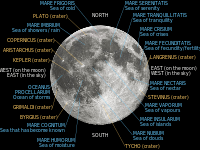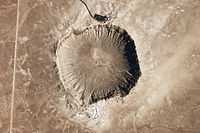Distance to the Moon

This laboratory is an activity for you to determine a distance to the Moon.
Some suggested entities to consider are right ascension, declination, circular orbit, longitude, and latitude.
Evaluation
|
Okay, this is an astronomy distance, or displacement, laboratory.
Yes, this laboratory is structured.
I will provide an example of calculations of the distance to the Moon. The rest is up to you.
Questions, if any, are best placed on the discussion page.
Control group
For measuring a distance to the Moon, what would make an acceptable control group? Think about a control group to compare your experimental results and calculations to.
Sampling

One way to calculate an estimate for the distance to the Moon is to use a feature that occurs both on Earth and on the Moon. Subject to size and magnification, the distance should be a function of perceived size. The diameter of the Meteor Crater in the image is 35 mm. For an observer at the level of the crater, it is 1,186 km in diameter. The angle between the observer's path vertically decreases from 90° as the distance of the observer from the crater rim increases from 593 km for an observer starting level with the crater rim at the center.
Landsat 1 has a periapsis of 897 km and an apoapsis of 917 km, for an average of 907 km. If the Barringer Meteor Crater was photographed by Landsat 1 at a magnification of 1 it produced a 35 mm diameter image at 907 km. This suggests a photographic "shrink factor" equal to the actual diameter in mm divided by 35 mm or 3.39 x 107. As the perceived size shrinks with distance from the crater, the "shrink factor" should remain constant until the camera onboard can no longer image the crater (spatial resolutions ranging from 15 to 60 meters).
For the Meteor Crater image:
For example, if the size of a crater in the image at the top of the page is 1 mm and the image was taken by the same Landsat 1 camera, then the distance to the crater is approximately 35 times the distance of Landsat 1 above the Meteor Crater or 31,745 km.
If there are 9 pixels/mm, then a comparable crater of one pixel diameter corresponds to a distance of 285,705 km. For a Moon at an average distance of 384,000 km, there would need to be at least 12 pixels per mm.
"A lunar observation by Landsat could provide improved radiometric and geometric calibration of both the Thematic Mapper and the Multispectral Scanner in terms of absolute radiometry, determination of the modulation transfer function, and sensitivity to scattered light. A pitch of the spacecraft would be required."[1]
Therefore, Landsat can take an image of the Moon. If its minimal image size corresponds to a crater comparable to the Meteor Crater, then such a Landsat image would yield a value for the distance to the Moon.
Report
Title
by line
Abstract
Introduction
Experiment
Results
Discussion
Conclusion
Evaluation
To assess your calculations, including your justification, analysis and discussion, I will provide such an assessment of my example for comparison.
Evaluation
Research
Hypothesis:
- The width of a feature decreases perceptively the further away vertically the observer travels.
Control groups

The findings demonstrate a statistically systematic change from the status quo or the control group.
“In the design of experiments, treatments [or special properties or characteristics] are applied to [or observed in] experimental units in the treatment group(s).[2] In comparative experiments, members of the complementary group, the control group, receive either no treatment or a standard treatment.[3]"[4]
Proof of concept
Def. a “short and/or incomplete realization of a certain method or idea to demonstrate its feasibility"[5] is called a proof of concept.
Def. evidence that demonstrates that a concept is possible is called proof of concept.
The proof-of-concept structure consists of
- background,
- procedures,
- findings, and
- interpretation.[6]
See also
References
- ↑ H. H. Kieffer and R. L. Wildey (September 1985). "Absolute calibration of Landsat instruments using the moon". Photogrammetric Engineering and Remote Sensing 51 (09): 1391-3. http://adsabs.harvard.edu/abs/1985PgERS..51.1391K. Retrieved 2015-06-17.
- ↑ Klaus Hinkelmann, Oscar Kempthorne (2008). Design and Analysis of Experiments, Volume I: Introduction to Experimental Design (2nd ed.). Wiley. ISBN 978-0-471-72756-9. http://books.google.com/?id=T3wWj2kVYZgC&printsec=frontcover.
- ↑ R. A. Bailey (2008). Design of comparative experiments. Cambridge University Press. ISBN 978-0-521-68357-9. http://www.cambridge.org/uk/catalogue/catalogue.asp?isbn=9780521683579.
- ↑ "Treatment and control groups, In: Wikipedia". San Francisco, California: Wikimedia Foundation, Inc. May 18, 2012. Retrieved 2012-05-31.
- ↑ "proof of concept, In: Wiktionary". San Francisco, California: Wikimedia Foundation, Inc. November 10, 2012. Retrieved 2013-01-13.
- ↑ Ginger Lehrman and Ian B Hogue, Sarah Palmer, Cheryl Jennings, Celsa A Spina, Ann Wiegand, Alan L Landay, Robert W Coombs, Douglas D Richman, John W Mellors, John M Coffin, Ronald J Bosch, David M Margolis (August 13, 2005). "Depletion of latent HIV-1 infection in vivo: a proof-of-concept study". Lancet 366 (9485): 549-55. doi:10.1016/S0140-6736(05)67098-5. http://www.ncbi.nlm.nih.gov/pmc/articles/PMC1894952/. Retrieved 2012-05-09.
External links
- African Journals Online
- Bing Advanced search
- Google Books
- Google scholar Advanced Scholar Search
- International Astronomical Union
- JSTOR
- Lycos search
- NASA's National Space Science Data Center
- Office of Scientific & Technical Information
- Questia - The Online Library of Books and Journals
- SAGE journals online
- The SAO/NASA Astrophysics Data System
- Scirus for scientific information only advanced search
- SpringerLink
- Taylor & Francis Online
- Universal coordinate converter
- Wiley Online Library Advanced Search
- Yahoo Advanced Web Search
| |||||||||||||||||||||||||||||||||||||||||
| ||||||||||||||||||||||||||||||||||||||||||||
![]() This is a research project at http://en.wikiversity.org
This is a research project at http://en.wikiversity.org
| |
Development status: this resource is experimental in nature. |
| |
Educational level: this is a research resource. |
| |
Subject classification: this is an astronomy resource. |
